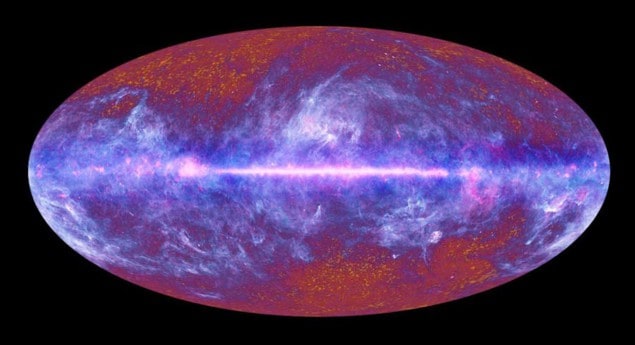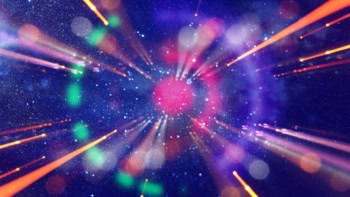
How can we tell if another universe has collided with our own? Physicists in Canada and the US believe they have the answer – it would leave “a unique and highly characteristic” imprint in the microwave background that pervades the cosmos. The physicists claim that the prediction can be tested using existing and future space telescopes, which contradicts a widespread view that the existence of a multiverse is untestable.
Chuck Bennett, an astrophysicist at Johns Hopkins University in Maryland, US, who was not involved with the study, believes the prediction helps bring multiverse theory into the realms of conventional, falsifiable science. “Science relies on being able to falsify ideas through experiment or observations of nature,” he says. “The fact that these potentialities exist enables us to call this ‘science’. That, to me, is a significant statement.”
The possibility of a multiverse comes from both string theory and inflation theory, the idea that our universe underwent a rapid expansion just after the Big Bang. Inflation theory does a good job of explaining why space is fairly smooth on large scales, but researchers can’t explain what started the expansion and what stopped it. These problems have led physicists to consider the possibility that inflation could occur at other places and times, generating new universes in addition to our own.
Metaphysical problem
The idea of a multiverse is highly controversial. One problem is metaphysical: the universe seems big already, without having to contend with a potentially infinite number of others. Yet perhaps a bigger problem is scientific. If observations are limited to our own observable universe, how can scientists test whether a bigger multiverse exists? The answer to that has been that, from time to time, another universe in the multiverse might collide through ours, leaving a “wake” in its path. But figuring out precisely what such a wake would look like hasn’t been easy.
Now, however, Kris Sigurdson of the University of British Columbia in Vancouver and others say they have calculated the detailed features of a cosmic wake. They have considered the possibility that our universe collided with another before our inflation period, because, they say, the latter would have erased the wake’s evidence. Even though this happened more than 13 billion years ago, the wake would have been preserved in the cosmic microwave background (CMB), which was formed some 380,000 years into the universe’s existence.
Look for a ‘double peak’
The focus of the prediction is in the polarization of photons in the CMB. Photons have two transverse polarization states, and any that come from a certain region in the CMB might be mostly in the same polarization state, or in a mix of both. Sigurdson and colleagues calculate that, providing the wake was big enough, it ought to imprint the CMB with a characteristic “double peak”: two close rings where the photons sway towards a single polarization state.
The prediction is not strictly the first to arise from multiverse theory. In 2007 researchers at the University of California at Santa Cruz, US, also suggested that a cosmic wake could imprint itself on the CMB; then, earlier this year, a group led by Hiranya Peiris of University College London found hints that this prediction was true. But these predicted features were too vague, say Sigurdson and colleagues, and might have existed in the CMB anyway.
Evidence for string theory?
“[Our] features represent the first verifiable prediction of the multiverse paradigm,” write Sigurdson and colleagues in their preprint, which they uploaded to the arXiv server last month. “A detection of a bubble collision would confirm the existence of the multiverse, provide compelling evidence for the string theory landscape, and sharpen out picture of the universe and its origins.” Physics World was unable to speak to the researchers about their preprint because they are submitting it to a journal that employs an embargo policy.
If the prediction is correct, it should be possible to test it in upcoming data from the European Space Agency’s Planck space observatory and future CMB missions, say the researchers. Yet Bennett, the principal investigator on NASA’s Wilkinson Microwave Anisotropy Probe, another CMB space observatory, thinks the detection of a cosmic wake would nonetheless be “extremely unlikely”. He says the amplitude of a wake would have to be just right: too small and we wouldn’t see it; too big and it would probably have had severe consequences for our universe’s structure. The number of collisions would also have to be “fine-tuned”, he says.
Infinite number of wakes
“The claim seems to be that we might see one or two wakes in our sky, but why one or two?” he adds. “Why not none or an infinite number? In fact, if bubble collisions were common we would not be alive to discuss the question.”
Cosmologist Arjun Berera at the University of Edinburgh, UK, also thinks the idea of a multiverse – and by extension Sigurdson and colleagues’ prediction – is speculative. But he notes that a positive detection would be “spectacular”. “Such a case would offer suggestive evidence in support of string theory,” he says. “On the other hand, no evidence in the CMB data for a collision between two universes would not rule out string theory, it would simply extend the widely held belief in the field that string theory is unfalsifiable.”
The research is described in arXiv:1109.3473.



